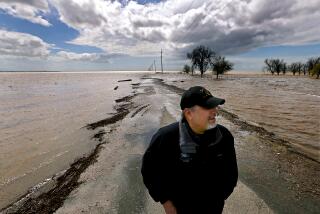A Drought That Never Dries Up : North and south will have to work together as never before
- Share via
You can’t get much further from California’s rainy season than August, when even our normal coastal winds and fog can’t compete with the heat and when the only promise of “relief” on the horizon are the hot, dry Santa Ana winds of late summer and early fall. Still, it’s not too early to start praying for rain.
That’s because unless the coming rainy season is at least as wet as last winter, California is in for a seventh straight year of drought. That would mean, at the very least, higher water bills for all of us, and possibly even water rationing if anything close to the worst-case scenario comes to pass.
First, some recent history: For six consecutive years rainfall in Northern California has been below normal. That’s important because a lot of the water that folks from Los Angeles to San Diego rely on comes from up north--from the Sierra snowpack and big rivers such as the Stanislaus, Feather and Sacramento. Even when Southern California has considerable rain, like last winter and spring when the figure hit 113% of normal, it helps only a little because this part of the state has enough reservoir capacity to save just a fraction of rainfall. So we are wedded to the water fate of our neighbors north of the Tehachapi Mountains, not just Central Valley farmers but fellow city dwellers in places like San Jose and Fresno.
RECORD LOWS: That’s why Southern Californians must be concerned about statistics compiled by Times staff writer Virginia Ellis, who recently surveyed the state’s biggest reservoirs. She found that all of them--whether they are part of the State Water Project or are used to store water for the Central Valley Project, which is run by the federal Bureau of Reclamation--will be at or near record lows by autumn.
Even the flat bureaucratic language of a recent report by the state Department of Water Resources does not try to downplay the potential crisis: “By this fall, California’s two big water systems . . . will have only minimal reserves left for next year.”
OLD CHALLENGE: There will be slightly more than 1.5 million acre-feet in state-run reservoirs, compared to almost 2.5 million when the drought began in 1987. And federal reservoirs will be down to 3 million acre-feet, from 6.3 million in 1987. To turn this situation around, runoff must be well above average and sustained. However, historical records indicate that even in periods of abundant rainfall, significantly above average amounts occur only three years in every 10. So it is simply not wise to count on plentiful rainfall next winter. We must plan for the worst while hoping for the best.
That means all of us, city dwellers and farmers, must continue to conserve water until at least year’s end, when--we all hope--the skies will open up with rain not just for Southern California but for our friends up north.
More to Read
Sign up for Essential California
The most important California stories and recommendations in your inbox every morning.
You may occasionally receive promotional content from the Los Angeles Times.










